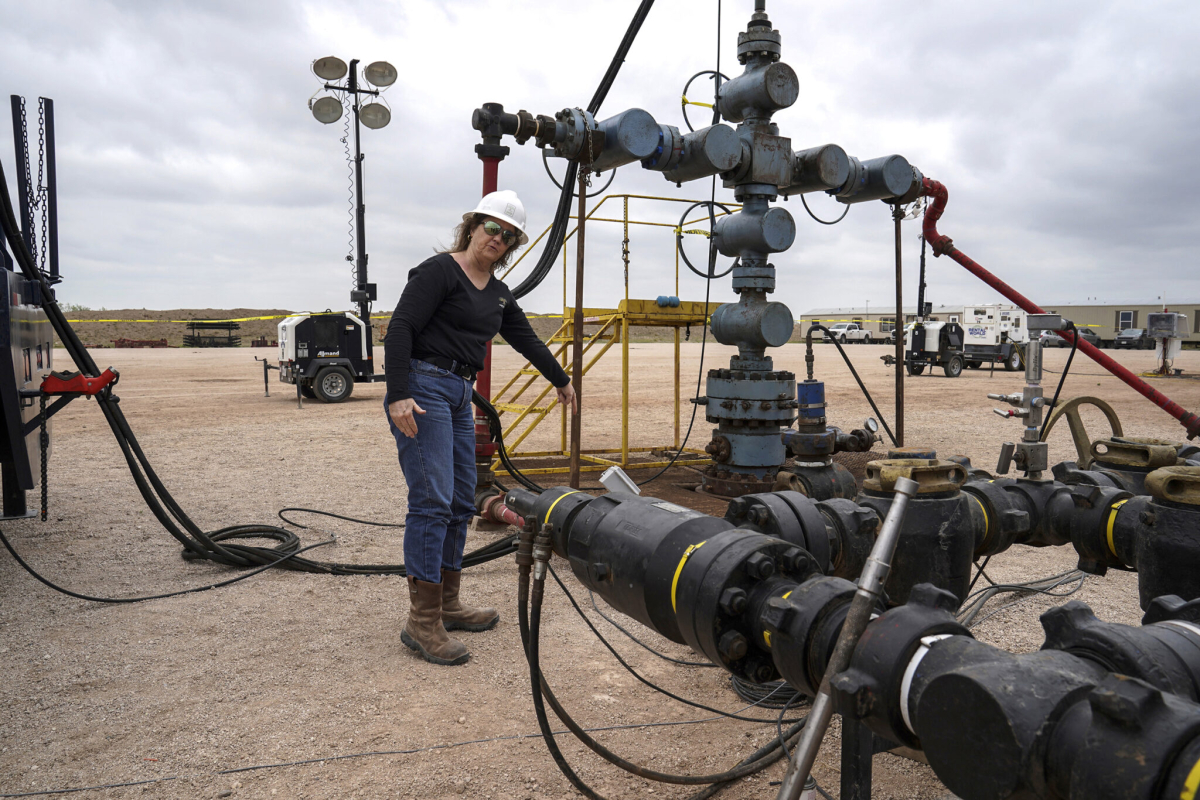Support strong Canadian climate journalism for 2025
This story was originally published by Inside Climate News and appears here as part of the Climate Desk collaboration
The rapid buildout of wind and solar power generation has set off a race for experimental technologies to capture and store that energy. Several startups in Houston say they’ve developed ways to cache it underground, and one just announced its first commercial project.
Sage Geosystems Inc. called its project “the first geothermal energy storage system to store potential energy deep in the earth and supply electrons to a power grid” in an Aug. 13 announcement. It plans to install its system alongside a solar farm in South Texas.
Energy storage enables excess power to be saved for periods of poor generation so, for example, a solar farm could run a city at night. For the most part, this race has produced explosive growth for lithium ion battery technologies and markets, along with a worldwide scramble for the rare earth minerals they require. But around the edges, a flurry of startups hopes for emerging technologies to meet the new generation of storage demands.
Many energy storage technologies are in early stages of development, including compressed air energy storage, hydrogen-based systems and various forms of thermal storage. Researchers and investors don’t know which technologies will end up being viable in terms of costs and ease of use.
In recent years, Texas has quickly become the nation’s top producer of renewable energy, as well as its top market for utility-scale energy storage.
“There is a growing need for technologies that can adjust generation levels to maintain grid stability,” said Yiyi Zhou, an energy analyst at BloombergNEF. “The technology Sage is developing has the potential to be a game changer.”
Sage is not the only startup working in this space. Two other Houston-based companies, Fervo Energy and Quidnet Energy, also claim proprietary technology they plan to use for geothermal energy storage and generation. All three plan to inject water underground at high pressure.
The system works like this: Electricity from solar farms, wind turbines or other forms of renewable energy is used to pump water into specially created underground caverns or reservoirs, where it can be stored under pressure. When the electricity is needed, valves sealing the underground cavern are opened, sending the pressurized stored water back up to the surface, where it will turn a turbine to generate power.
“This form of pressurized water storage is very novel, and to our knowledge, companies like Sage Geosystems, Quidnet Energy and Fervo Energy are all pioneering this new technology,” said Chetan Krishna, head of research and development at Third Derivative, a climate-focused startup accelerator.
Pressurized water is an old idea. The innovation, Krishna said, is the process for creating underground reservoirs to hold it. While traditional geothermal energy projects typically need natural subterranean systems of caverns, these companies say they can make their own caverns almost anywhere. In addition to energy storage, all three companies also hope to develop geothermal power generation using the same techniques.
Sage’s process, which it calls its Geopressurized Geothermal System (GGS), resembles hydraulic fracturing for oil and gas, according to the company’s chief geoscientist, Mike Eros, but at about a tenth the scale and intensity. Instead of a fleet of compressors, it uses a heavy mineral mud, a wider well and gravity to punch a vertical fracture in rock thousands of feet below the surface.
The system uses the excess renewable energy from solar, wind or geothermal plants to pump water into these fractures at high pressure and then releases it when it is needed. According to Eros, the system can store energy with 75 percent efficiency for up to 10 hours, and can jettison a nine-inch stream of water at 5,000 pounds per square inch to turn a generator turbine.
“We call it an Earth battery,” said Eros, who previously worked 12 years at ExxonMobil. “Compressed water energy.”
He said the main risks of the system were groundwater contamination and the creation of “runaway fractures” in the ground. Sage took precautions to mitigate these risks, Eros said, such as detailed geological mapping to avoid injection into existing faults.
In a related development on Monday, executives from Sage and Facebook’s parent company Meta, and officials from the U.S. Department of Energy, announced that the companies will use Sage’s GGS technology to create geothermal energy “virtually anywhere.”
“Hot dry rock is a vastly abundant resource compared to traditional hydrothermal formations, making Sage’s GGS technology a highly scalable approach with the potential for rapid expansion across the U.S. and globally,” the companies said in a joint press release issued after their announcement at DOE’s Catalyzing Next Generation Geothermal Development Workshop in Washington.
Meta plans to use Sage’s GGS technology “to provide carbon-free power to Meta’s data centers,” the companies said, but didn’t specify where.
The first commercial project using GGS for geothermal energy storage will be built on land leased from the San Miguel Electric Cooperative in Christine, Texas, and linked to a solar farm there. It will enable Sage to buy power during peak production, store it and sell it back to the grid at night.
Unlike the plans Sage announced with Meta generating geothermal heat, the first storage project will use only pressure, Eros said, because “we have to walk before we run.” Later, more advanced storage efforts, he said, would involve geothermal heat.
Ultimately, the economic viability of these systems will depend on how its costs stack up against lithium ion batteries, the most popular new form of energy storage.
Five years ago, lithium ion batteries accounted for less than 4 percent of U.S. energy storage. In June of this year, after millions of battery installations, they made up more than 40 percent, according to data from the Department of Energy, and they could surpass 50 percent by the year’s end.
Batteries are supplementing the most traditional method of energy storage, called pumped hydro, in which water is pumped uphill during peak generation, then allowed to flow downhill and turn power turbines during peak energy demand.
Storage duration has been a limiting factor for batteries, however. Most utility-scale batteries in the U.S. work best for up to four hours of storage. Newer systems are achieving six to eight hours, but at a higher cost.
The technologies will ultimately be judged according to a metric called the levelized cost of storage. According to calculations from the Third Derivative accelerator, lithium ion batteries can achieve six hours of storage at an average levelized cost of $72 per megawatt hour. Meanwhile, Sage claims up to 10 hours of storage at $100 per megawatt hour when combined with solar generation.
“That’s certainly better than where lithium ion battery storage is,” said Ramanan Krishnamoorti, vice president of energy and innovation at the University of Houston. “This company has obviously made a breakthrough here.”
It remains unclear if the storage technology will hold up on the market. Lithium ion batteries are making rapid advancements, and researchers are developing alternative materials that could drastically change the equation, Krishnamoorti said. Still, there may be room for multiple systems in the fast-growing market for energy storage.
“Each will be an important contribution to solving energy storage needs,” said Lisa Biswal, associate dean of engineering at Rice University in Houston. “I’m excited, as a researcher in the area of energy, to be able to see commercial deployment of grid-scale lithium battery systems as well as geothermal.”
Researchers and investors will be watching closely to see if Sage’s projected storage times and costs hold up in its first commercial project. Last year, Sage demonstrated the technology in a non-commercial pilot.
“The technology has really only come together in the last few years to make it practical,” said Ken Wisian, an associate director of the Bureau of Economic Geology at the University of Texas who worked with Sage on a previous project. “The main thing holding it back is getting the first commercial project up and running.”
If the project goes well, Wisian suggested that geothermal energy storage could follow a similarly steep rate of deployment in Texas as wind, solar and battery projects have recently.
“It’s gone from almost no interest to suddenly a commercial project in a very short time,” he said. “One of my dreams is to see one of these energy storage wells drilled next to every wind generator in the state.”





Comments
When it comes to fracking, I really question the science behind it based on what they are doing. It seems whenever you start messing with the planet, there are always side-effects, and fracking of any kind seems to result in more earth tremors and instabilities in the same area.
Their real competition may be from the iron-air type of batteries developed by Form Energy. Their factory in Virginia opened this month:
https://formenergy.com/form-energy-hosts-west-virginia-appreciation-eve…
...and we will soon know what their selling price is, and soon after that...how they work.
The iron-air reaction runs for 120 hours, five days.